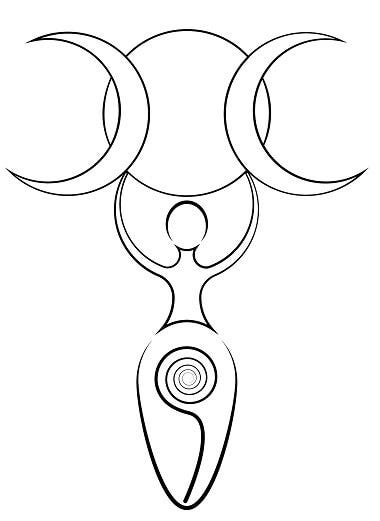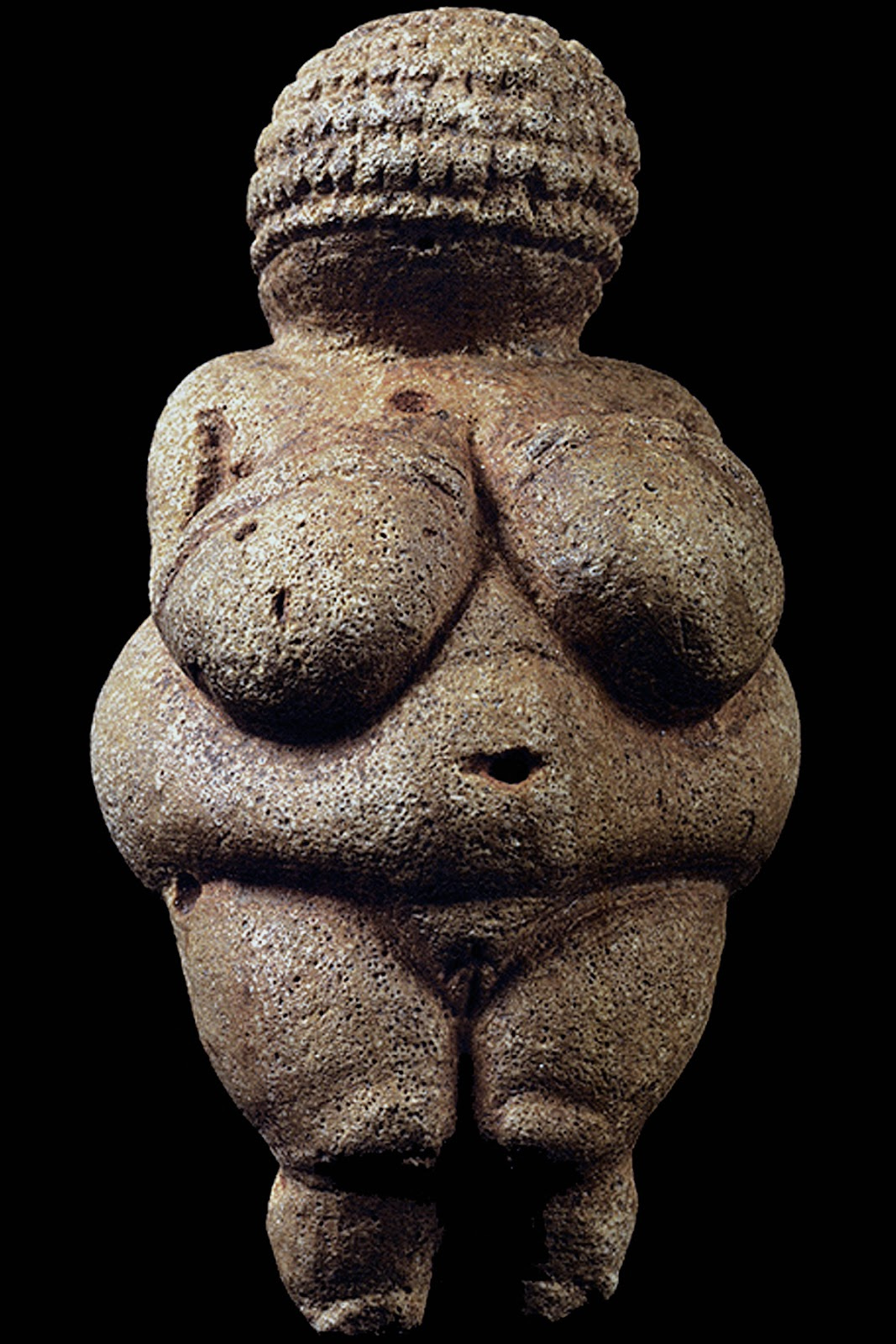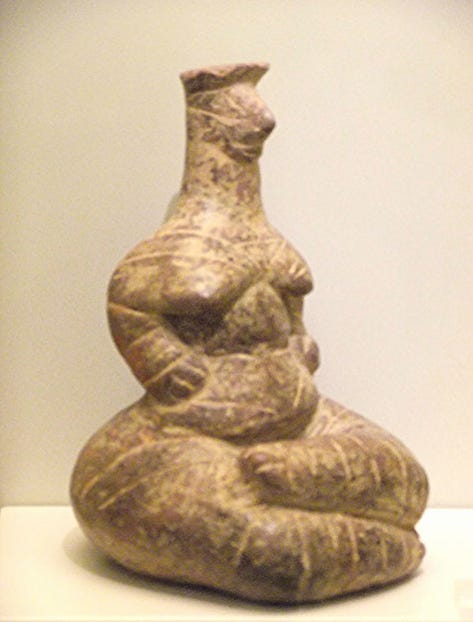Original Matriarchy and the Goddess Movement
Original Matriarchy and the Goddess Movement ✿ Pinterest trends, Bachofen, Engels, Budapest, Radford Ruether, Starhawk, Christ
Welcome to A Mum with a Book. This week and in the weeks to follow, I will be dissecting the Goddess Energy Aesthetic trend. Please like and share if you enjoy reading this post.
According to Pinterest Trends for 2025, the Goddess Aesthetic is going to be big this year. So, where does it come from? I'd say it's a mix between the original matriarchy, the goddess movement and the greek goddess myths. Let's go!
Original Matriarchy
The prehistoric period has been a site for lots of speculation since there aren’t any written records and the objects that have survived have been open to subjective interpretations. It has been up to the researcher, inscribed in a certain context, to interpret the findings. It isn’t uncommon for different researchers to have explained the meaning of the same object in different ways because of this. For example, in Goddesses and the Divine Feminine Rosemary Radford Ruether writes that a rounded implement made of stone has been interpreted as a club with which men killed animals or a tool for women to pound grains with, depending on the theory they were trying to prove. The statues of female forms were also taken as evidence of the matriarchal origin of humanity, since they were taken as instances of female worship.
Because of this, there are varying theories regarding gender roles during the Prehistoric period. The most common theory stems from the biological differences between human beings. In this theory, women and men have distinct roles that have to do with their physical abilities: Men are stronger so they are in charge of hunting and defense against animals or other humans while women take care of the children, prepare the food the men bring home and gather berries and fruit.
In the mid-nineteenth century, J.J. Bachofen put forward the idea of ‘’the mother right’’. Bachofen believed there may have been a matriarchal origin to humankind. Bachofen’s work, together with later works by Lewis Morgan and John Fergusson McLenan among many others, explored the ways matriarchal society operated and why it came to an end with the advent of the patriarchy.
Anthropologists largely took up this line of thinking and it was then used as ‘’political ammunition’’ by Frederich Engels, Karl Marx and by communists, first-wave feminists and even fascists. Engels,in Origin of the Family, Private Property, and the State, lent weight to the theory because he believed it was the first instance of oppression of women by men. For Engels, the overthrow of matriarchal power was the model of all subsequent oppressions leading to the relationship between worker and owner.
The appeal of an original matriarchy depended on the writer’s viewpoint.
Bachofen believed the matriarchal period was the prelude to civilization, which was only reached fully when the patriarchal rule became commonplace. The prehistoric period was nice but being ruled by women’s instincts rather than men’s rationality was not his cup of tea.
Engels encouraged the idea of an original matriarchy because he took it to mean there was hope for the oppressed. He believed the communist matriarchy that existed during the prehistoric period was primitive but it was the foundation of what could be aspired to in the future in a more refined form.
For female anthropologists, the matriarchal origin of humanity was empowering. They began studying cultures that were technologically less advanced as being representative of their prehistoric roots. This way, the matriarchal societies that were still alive during the study were taken as validation for their theories. However, critics believe it is unfounded to believe a society existing at the same time as your own can be representative of such a far away past.
For feminists, the work on matriarchal origins was taken as evidence of a patriarchal conspiracy to hide the truth in order to keep women subjugated.
The problem with the idea of the prehistoric matriarchal society is that the studies were based on literature, myth and the interpretation of objects that were considered to belong to that period. Anthropologists were criticised for dealing in what they claimed to be absolute truths without the necessary evidence based back-up. Because of this, the original matriarchy theory lost popularity within the field by the 20th century until it was rediscovered in the 1970s by the feminists that would begin The Goddess Movement.
The Goddess Movement
During the 1970s, sectors of the feminist movement re-discovered the concept of the Original Matriarchy in their search for a female spirituality based around values of peace, harmony with nature, equality and love. The idea was developed taking inspiration from non-European goddesses and cultures as a sign of an original natural female state. This group of feminists became known as the Goddess Movement. After the re-discovery of Bachofen’s and Lewis’ books, several new works were popularized and led to a true revival of feminine divine worship.

The most radical example can be found in Elizabeth Gould Davis’ The First Sex, in which she argues women were the only human beings that existed during the prehistoric period. She believed they reproduced pathogenetically, like some plants, and that the development of male genes was due to a genetic mutation, which meant that their very genetic makeup was already criminal, as they derived it from stealing the female chromosomes and breaking them into two. Her ideas were extreme and didn’t do much to help the movement’s credibility in the years to come.
Z. Budapest, a very rebellious member of the Goddess Movement was a key proponent of Wicca and the feminist witchcraft revival that is still active today in the revival of astrology and the witch aesthetic. Budapest claimed her mother was a witch and had shared the original story of creation with her so that she shared it with the world. She taught other women about the once universal religion of ‘’goddess worship’’ and its principles, which were love and a cultivation of the self in relation to health and beauty. Budapest argued the matriarchal civilizations prioritized sexual pleasure and understanding complicated feelings at the same time as they gave importance to taking care of their bodies and decorating them with jewelery and also painting and other forms of creative expression. Men in these societies went from sons to lovers but never seeked domination, since society revolved around peace and harmony.
Budapest also criticised other religions, since even though some of them, like certain Asian and African cultures or Christianity with the Virgin Mary, had feminine symbols, they had all ultimately embraced patriarchal gods. She wrote several books about the necessary tools and rituals for women who were interested in tapping into their goddess power. Some of the tools were candles, oils, incense and the setting up of an altar that were helpful for the many spells or incantations that ranged from spells for health or love to some that would hurt a rapist or free political prisoners.
A less confrontational proponent of Wicca was Starhawk, who argued that the Jungian male/female duality only led to more violence so she embraced a view of Wicca that was inclusive and acknowledged the power of males and females equally. Starhhawk also seeked out people from other ethnicities in her search for spiritual knowledge, as she believed non-white cultures were more in touch with their spiritual traditions. The supposed inclusivity of the practice varies depending on the practitioner, with some saying the triple goddess has no race and others considering the Wicca practice to be Euro-centric since its origins.
Carol Christ, an academic who rediscovered the goddesses' love by taking women on pilgrimages to Crete, where they would perform rituals at the sites of ancient goddess worship, also believed the power of the goddess was in her ability to take society away from the female/male duality into an all encompassing fluid state. Her views on the original matriarchy are interesting, since she believed that the prehistoric period was a time of egalitarian society which slowly disintegrated for a number of different reasons. Christ was one of the goddess worshippers who believed the patriarchy was directly linked to the environmental crisis. There is a documentary about this The Goddess, in Christ’s work, has the power to unsettle patriarchal structures that hold violence and injustice. Here, I am reminded of Gloria Anzaldúa’s Coatlicue State.
Coatlicue was one of the Aztec fertility goddesses, who I will explore in more detail in another post. What is relevant here is the understanding of the Coatlicue state as a state of upheaval in which change is created. Christ’s views seem to think the goddess, in the same way as Coatlicue, leads to change but necessitates a period of conflict within and between individuals before peace can be reached.
By exploring the original matriarchy and the Goddess Movement, I think there is ample food for thought about where the psychological/internal aspects of the Goddess Aesthetic comes from. In the following post, I will be exploring the Greek goddesses as archetypes in a sort of ‘’Choose your goddess’’ game and covering non-Western goddesses that have inspired the look.
Works referenced
Ruether, Rosemary. Goddesses and the Divine Feminine : A Western Religious History, University of California Press, 2005. ProQuest Ebook Central, https://ebookcentral-proquest-com.bibliotecauned.idm.oclc.org/lib/unedbiblioteca-ebooks/detail.action?docID=231914.
Eller, Cynthia. Gentlemen and Amazons : The Myth of Matriarchal Prehistory, 1861-1900, University of California Press, 2011. ProQuest Ebook Central, https://ebookcentral-proquest-com.bibliotecauned.idm.oclc.org/lib/unedbiblioteca-ebooks/detail.action?docID=784535.
https://www.bustle.com/beauty/goddess-energy-aesthetic-beauty-trend-skin-makeup-nails
Alleyn Diesel. “Womanspirit.” Agenda: Empowering Women for Gender Equity, no. 19, 1993, pp. 71–75. JSTOR, https://doi.org/10.2307/4065999. Accessed 13 Dec. 2024.
Dijk, Denise. “The Goddess Movement in the U.S.A. A Religion for Women Only.” Archiv Für Religionspsychologie / Archive for the Psychology of Religion, vol. 18, no. 1, 1988, pp. 258–66. JSTOR, http://www.jstor.org/stable/23918114. Accessed 13 Dec. 2024.
“----Arrest Feminist Witch.” Off Our Backs, vol. 5, no. 4, 1975, pp. 14–14. JSTOR, http://www.jstor.org/stable/25783999. Accessed 13 Dec. 2024.









So happy to have stumbled across your account! I am also interested in myths and folklore from around the world and how it can shape narratives of our world today. Can’t wait to follow along 😊❤️
Coatlicue! Happy to see her here after your introducing me to her. What a great read this was.